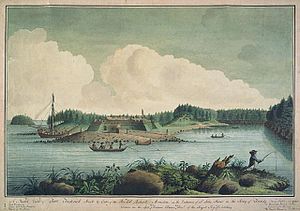The Raid on Saint John took place on 27 August 1775 during the American Revolutionary War. The raid involved American privateers from Machias, Commonwealth of Massachusetts Bay attacking Saint John, Nova Scotia on the northeast shore of the Bay of Fundy(in present day New Brunswick).[5][6][7][8] The privateers intended to stop the export of supplies being sent to the loyalists in Boston. This raid was the first hostile act committed against Nova Scotia and it resulted in raising the militia across the colony.[9]
| Raid on Saint John | |||||||
|---|---|---|---|---|---|---|---|
| Part of the American Revolutionary War | |||||||
 Fort Frederick (Saint John, New Brunswick) | |||||||
| |||||||
| Belligerents | |||||||
|
| |||||||
| Commanders and leaders | |||||||
|
|
| ||||||
Background
During the American Revolution, Americans regularly attacked Nova Scotia, the coasts of modern day Nova Scotia and New Brunswick by sea and land. American privateers devastated these small maritime economies by raiding many of the coastal communities,[10] such as the numerous raids on Liverpool and on Annapolis Royal.[11]
Barely a month after Lexington & Concord, there was a great naval success by 30 American militia men in the sloop SUCCESS on 14 May 14 1775 who recaptured two ships and their Royal Navy crews, totaling 15. These vessels had been taken by HMS FALCON. This was on Buzzards Bay at the Battle off Fairhaven MA. A month later, 55 American militia men in two vessels had another naval victory on 12 June capturing the armed coastal patrol sloop HMS MARGARETTA and her crew of 40 at the Battle of Machias, actually happening 12 miles down the bay off Machiasport. In response to this defeat, in July 1775 the British sent two armed sloops, HMS DILIGENCE and HMS TATAMAGOUCHE from Halifax to punish the American rebels. On 12 July 1775, the British vessels confronted O'Brien in UNITY and PORTLAND PACKET on the Bay of Fundy, where the Americans captured the British ships.[12] The Machias Committee of Safety sent Captain Stephen Smith to capture the brig LOYAL BRITON at St. John, which was loading cattle and other supplies for the British Army at Boston.[13]
Battle
On 27 August 1775, Captain Stephen Smith, in a 4-gun American privateer from Machias, along with 40 militia men raided St. John and burned Fort Frederick and took the brig LOYAL BRITON under the command of Captain Frederick Sterling. The brig had 120 tonnes of sheep and oxen for the British forces in Boston. Sterling also took a corporal and two privates, with two women and five children prisoner. John Anderson Esq. was also on board the brig.[14] The brigantine was owned by John Sempill (Semple) and the navigator was David Ross, who both escaped. The prisoners were released at Boston and sent back to St. John.[15]
Aftermath
Captain Edward Le Cras of HMS SOMERSET and HMS TARTAR proceeded immediately to Annapolis Royal to protect the town on the southeast shore of the Bay of Funday. The Governor requested two sloops-of-war to patrol the Bay of Fundy. Admiral Samuel Graves assigned Captain William Duddingston of HMS SENEGAL to the task. Graves also sent Le Cras to protect Halifax for the winter.[16] Governor Legge of Nova Scotia also called up militias from across the colony to be stood up.[17]
In retaliation for the raid on St. John, the British executed the Burning of Falmouth, modern day Portland, Maine. American privateers remained a threat to Nova Scotian ports for the rest of the war.
See also
Notes
References
Wikiwand in your browser!
Seamless Wikipedia browsing. On steroids.
Every time you click a link to Wikipedia, Wiktionary or Wikiquote in your browser's search results, it will show the modern Wikiwand interface.
Wikiwand extension is a five stars, simple, with minimum permission required to keep your browsing private, safe and transparent.
